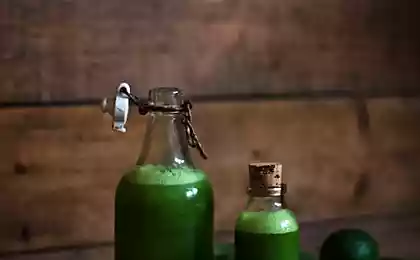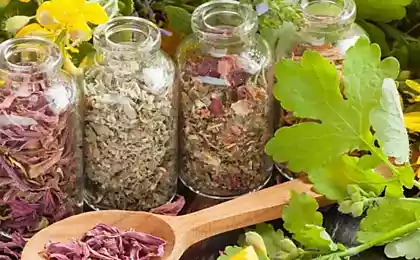484
Krovoochishchajushchee burdock root: properties and applications

Burdock root is consumed in peeled and boiled as a medicinal plant. It is believed that this plant has spread from Northern Europe and Siberia. In Japan, popular kind of gobo (burdock vegetable), which have long been cultivated due to the properties of the root. In Japan, burdock is even sold in supermarkets. In nature, burdock is a wild flowering plant that grows in almost all parts of the world. Researchers attribute the burdock family Asteraceae (Asteraceae), genus Arctium (burdock). Its scientific name is Arctium lappa (burdock burdock Burr). The largest plants reach one meter in height. Its wide heart-shaped rough leaves are rich green above and light green below. This mug resembles rhubarb.
In summer on its thick stems, reaching half-meter length, appear reddish-purple tubular flowers, of which later formed seed heads with hooked spines. Closer to the time of collection, it is brownish underground roots reach a length of about 60-90 cm and form have become like the carrot and parsnip.
Of the four species of the genus Arctium (burdock), are only cultivated a large burdock (Arctium lappa) and the small burdock (Arctium minus). Usually the roots are dug in the fall, slow dried and store for the winter. Burdock root is characterized by a sweet taste reminiscent of artichoke and parsnips. It has a crunchy and chewy texture. Almost all parts of the plant are used in cooking and as a medicine in certain ailments.
Use the roots of great burdock health
The roots of burdock, its young shoots, peeled stalks, and dried seeds contain numerous compounds known for their antioxidant properties, ability to prevent disease and improve health.
Burdock root is very low in calories and contains only 72 calories per 100 grams. Burdock is a good source of non-starch polysaccharides, inulin, glycoside lappin, mucilage and others that make burdock laxative. Additionally, inulin acts as prebiotic and helps reduce blood sugar and blood cholesterol, and body weight.
Burdock root in appreciable quantities contains the electrolyte potassium (308 mg, 6.5% of the recommended daily norms of consumption). Sodium in the mug a little. Potassium is an important component fluids of the cells and organism, helps control heart rate and blood pressure.
At the root of the burdock in small quantities also contains vital vitamins, including folic acid, Riboflavin, pyridoxine, nicotinic acid, vitamin E and vitamin C, essential for maintaining health. Vitamins E and C are powerful natural antioxidants that helps the human body to prevent infectious diseases, cancer and neurological diseases.
In addition, burdock root contains some essential human minerals — iron, manganese, magnesium and small amounts of zinc, calcium, selenium and phosphorus.
The use of burdock root in medicine
Almost all parts of burdock are used in traditional and modern medicine. In this he is like another member of the family Asterceae, dandelion.
Burdock is used in many folk remedies as one of the best remedies to clean the blood. It has certain diuretic properties, help rid the blood of toxins.
Burdock is used in the treatment of skin diseases, including eczema (dermatitis), psoriasis, dry skin and others. Part of the burdock has been used as herbal remedies for the liver and gallbladder.
The leaves and stems of burdock are also used as herbal appetite stimulant and a good remedy in complaints of gas and indigestion.
Selecting and storing burdock
Usually the burdock root up to 60 cm in length and 2.5 inches in diameter. Prefer medium size dense roots without damage and with elastic skin. Avoid quite dry and limp roots which may have lost its flavor.
The cleaned dried roots stored for several months in a cool well-ventilated place. Chopped roots should be stored in the refrigerator and use as quickly as possible.
Caution
Burdock root can be applied only to healthy people who have no contraindications. Patients undergoing treatment kalisberegatmi dioretikami, burdock root may cause potassium intoxication. In General some individuals the plant can cause allergic reactions.
The nutritional value of the root of the great burdock
In parentheses are the percentage of the daily allowance. Nutritional value is based on 100 grams of the root of the great burdock (Arctium lappa) according to information from the Ministry of agriculture of the USA, shown in the resource Nutrition And You.
General information:
energy value — 72 kilocalories (3,5%);
carbohydrates — of 17.34 grams (13%);
protein — 1.53 grams (3%);
fats — 0.15 gram ( cellulose, part of the food — 3.3 g (8%).
Vitamins:
folic acid (vitamin B9) — 23 micrograms (6%);
nicotinic acid (vitamin B3) — 0,300 milligrams (2%);
Pantothenic acid — 0,321 milligrams (6%);
pyridoxine (vitamin B6) — 0,240 milligrams (18%);
Riboflavin (vitamin B2) — 0.30 milligrams (2%);
thiamine (vitamin B1) is 0.010 milligrams (1%);
vitamin A — 0 international units (IU, IU) — 0%;
vitamin C — 3 mg (5%);
vitamin E is 0.38 milligram (2,5%);
vitamin K is 1.6 micrograms (1%);
Electrolytes:
sodium 5 milligrams ( potassium 308 mg (6.5 per cent).
Minerals:
calcium — 41 mg (4%);
iron — 0.80 milligrams (10%);
magnesium 38 mg (9%);
manganese — 0,232 milligrams (10%);
phosphorus 51 mg (7%);
selenium — 0.7 milligrams (1%);
zinc — 0.33 milligram (3%).
Phytonutrients:
alpha-carotene (α-carotene) — 0 micrograms;
beta-carotene (ß-carotene), which is rich in carrots — 0 micrograms;
beta-cryptoxanthin (ß-cryptoxanthin) — 0 micrograms;
lutein-zeaxanthin 0 micrograms.published
P. S. And remember, only by changing their consumption — together we change the world! ©
Source: hi-news.ru























